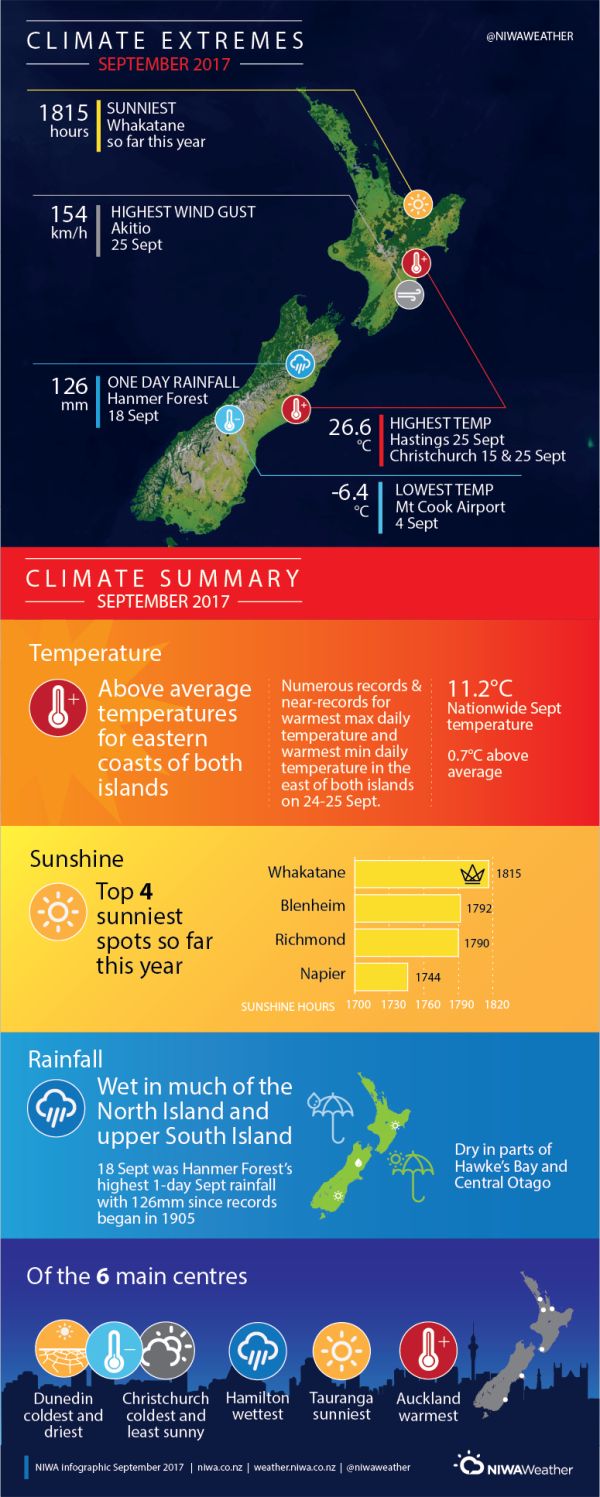A wet month for many and warm on the eastern coasts.
|
Rainfall |
September rainfall was well above normal (>149% of the September normal) or above normal (120-149% of the September normal) for large swaths of the North Island, including much of Waikato, western Bay of Plenty, Auckland, Manawatu-Whanganui, parts of Gisborne and Hawke’s Bay, much of the northern half of the South Island, along with eastern Otago and western Southland. Below normal rainfall (50-79% of the September normal) was observed in central and southern Hawke’s Bay, central Otago, and eastern Southland. |
|
Temperature |
September temperatures were near average (-0.50°C to +0.50°C of the September average) across large swaths of the country. Temperatures were above average (+0.51°C to +1.20°C of the September average) in parts of Auckland, Coromandel, northern and central Waikato, Gisborne, Hawke’s Bay, southern Manawatu-Whanganui, northern Marlborough, northern Canterbury, and much of Otago. Well above average temperatures (>1.20°C of the September average) were observed in small pockets of Hawke’s Bay, central Canterbury, and central Otago. |
|
Sunshine |
September sunshine hours were near normal (90-109% of the September normal) for much of the country. Above normal sunshine (110-125% of the September normal) was observed in parts of western Waikato and northern Manawatu-Whanganui, with below normal sunshine (75-89% of the September normal) in the lower North Island, interior Canterbury, and interior Otago. Isolated pockets of well below normal sunshine (<75% of the September normal) were observed in Wairarapa and central Canterbury. |
|
Soil Moisture |
As of 1 October 2017, soil moisture levels were near normal for a majority of the country. Soil moisture was slightly higher than normal for some coastal areas from Blenheim to Dunedin, as well as isolated pockets in Hawke’s Bay and near Cape Reinga. Soil moisture was lower than normal in southern Hawke’s Bay and Central Otago. |
Overview
September was characterised by lower than normal sea level pressure over the Tasman Sea and New Zealand, which resulted in regular bouts of rainfall moving across the country. This included an event on 6 September which produced heavy rain that trapped two tourists in their car in Waitomo. See the Highlights and Extreme Events section for full details.
In terms of temperature, large portions of the country experienced near average readings for the month. However, areas of above average and isolated well above average temperatures were recorded along the east coasts of both Islands, aided by frequent Foehn northwesterlies descending the lee side of the interior ranges and the Southern Alps. In fact, numerous records and near-records for highest maximum extreme temperature and highest minimum extreme temperature occurred on 24-25 September as northwesterlies brought a very warm air mass across the Tasman Sea from Australia, which was further enhanced in the east of both Islands by the Foehn effect.
Despite September being a wet month for many, frequent breaks in the wet weather also brought many partially sunny days. The swing between sun and cloud throughout September evened out so that overall the total sunshine hours were near normal for much of the country.
Further Highlights:
- The highest temperature was 26.6°C, observed at Christchurch (Riccarton) on 15 and 25 September, and at Hastings on 25 September.
- The lowest temperature was -6.4°C, observed at Mt Cook Airport on 4 September.
- The highest 1-day rainfall was 126.0 mm, recorded at Hanmer Forest on 18 September.
- The highest wind gust was 154 km/hr, observed at Akitio on 25 September.
- Of the six main centres in September 2017, Auckland was the warmest, Christchurch and Dunedin were the coldest, Hamilton was the wettest, Dunedin was the driest, Tauranga was the sunniest, and Christchurch was the least sunny.
- Of the available, regularly reporting sunshine observation sites, the sunniest four locations in 2017 so far (1 January – 30 September) are Whakatane (1815 hours), Blenheim (1792 hours), Richmond (1790 hours), and Napier (1744 hours).
Download
- September 2017 Climate Summary information [PDF 600KB]
- September 2017 Climate statistics [PDF 65KB]
Contact
Mr Seth Carrier, Meteorologist/Forecaster Tel. 09 375 4508

